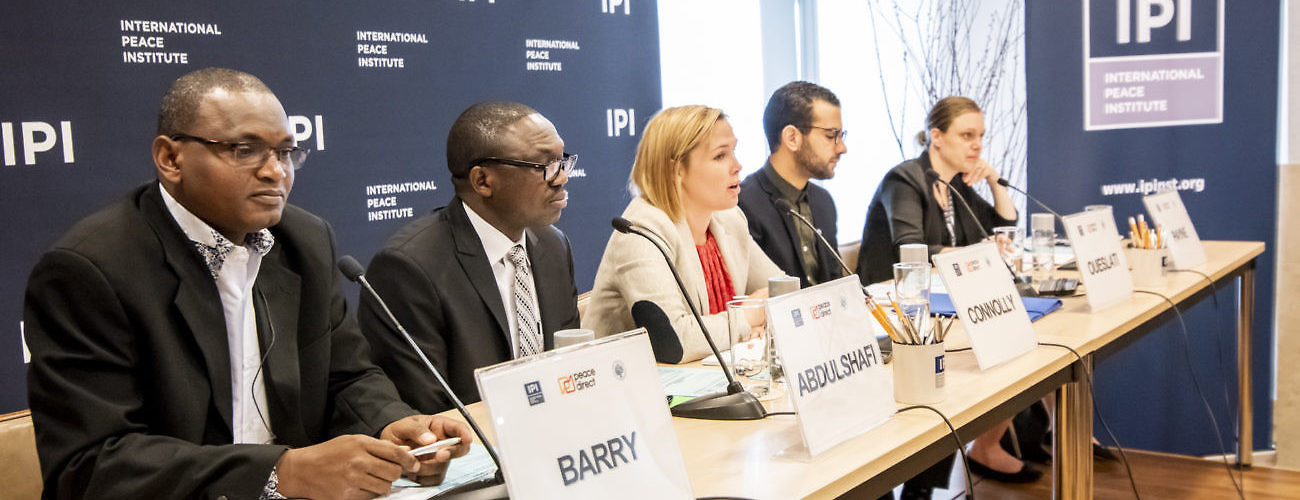An April 12th policy forum, co-hosted by the United States Institute for Peace (USIP) and Peace Direct, at IPI examined the role of nonviolent strategies in advancing long-term peace, and how these approaches can be put into complementary practice to advance the sustaining peace agenda.
Introducing the subject, Maria J. Stephan, Director of the Program on Nonviolent Action at the United States Institute of Peace, said, “A shift definitely seems to be occurring in the UN community, expanding the idea of peacebuilding to be more than a post-conflict effort, but a strategy that occurs at every phase of the conflict cycle and includes the voices of local actors in communities, including non-traditional civic groups and movements.”
She said that a study of 323 major violent and nonviolent campaigns from 1900 through 2006 showed that nonviolent campaigns were twice as effective in achieving their goals. “Nonviolent campaigns also attract significantly higher levels of participants and from more diverse segments of society compared to armed struggles,” she said. “We also found that empirically nonviolent campaigns are major drivers of democratic development.” This can be seen in such examples as mediation to end apartheid in South Africa, stopping civil war in Liberia, advancing a democratic transition in The Gambia and addressing systemic corruption in Guatemala.
Mamadou Tangara, the Permanent Representative of The Gambia to the UN, recounted attempts to manipulate young people in his country during the 2016 crisis when a sitting president initially resisted calls on him to make way for an elected opponent and the threat of violence arose. “But the youth were responsible enough not to follow the instruction given by either the ruling party or the opposition,” he said. “They decided to stay put at home and wait for the president’s time to expire and people to go about their business peacefully. And I think that’s one of the reasons why we were able to avoid a major conflict.”
Ala Oueslati, a Tunisian activist and Fellow of Women Deliver, highlighted the agency of young people by describing the success of the Arab Spring- era nonviolent movement in his country. “They changed the narrative in the region,” he said of Tunisian youth. “I heard many accounts from people of the way they organized themselves peacefully and nonviolently to reach a purpose or an outcome that had been overlooked by the government.”
Echoing a major tenet of the sustaining peace agenda, he said that Tunisian youth focused not on conflict so much as on what was already working in their society. “What is better than building peace is sustaining peace that has already been built,” he reasoned. “And that’s where the Tunisian successful model for young people comes out and stands out in a crowd of a lot of chaos in the region. It was either the voice of young people or the sound of tear gas and rubber bullets, to be honest. And the government was smart enough to hear the voice of young people, and it has been prioritizing investment in youth.”
Pressing the argument on the importance of involving youth by citing the dangers of not doing so, he said, “If they don’t feel like they belong somewhere, they will belong to organizations such as ISIS which gives them a platform, an alternative preference basically.”
Quscondy Abdulshafi, a local peacebuilding consultant with Peace Direct, said that as a young Sudanese student, he was faced with two choices. “One, which was more viable, was to travel to Darfur and join the army moment and fight the government to be part of the cause,” he said. “The other was to use the agency you have as a student to try to struggle and challenge the situation and build peace through activism.”
He chose the latter, and it led him to gain confidence in the grassroots nonviolent approach. “For me,” he said, “as somebody who hopes to see peace, I most strongly believe that peace can only be sustainable and viable in my country if it happens through stronger civil society involvement and a strong nonviolent movement that really allows for vertical and horizontal dialogue in society.”
Idrissa Barry, Coordinating Committee Member of Balai Citoyen in Burkina Faso, appealed to the international community to support the nonviolent movement that had rescued his country from a similar crisis owing to a president’s initial refusal to leave office when his term was up. “The UN and other organizations should be by our sides, by the side of citizen movements, to understand their motivation, to understand how they fight, what motivates them, what are their objectives, what do they want for their people,” he argued.
In Burkina Faso’s case, he said, “It is safe to say that these efforts have been crowned with a certain success. At first, nobody wanted to sit and talk to each other. Where it was the people and the vigilantes, they would just stare at each other. But after two years in the field, people are collaborating, they’re talking to each other, and we are consolidating these relationships based on mutual trust, and the current government is also supporting us in these efforts.”
Chelsea Payne, Policy Officer at the UN Peacebuilding Support Office (PBSO), said the discussion amply evidenced that “sustaining peace can only be realized through people-centered approaches and committed national inclusive ownership.”
Another point that she said had come through strongly was the importance of the international community’s “tapping into the peacebuilding potential of youth organizations, and often times this means improving access to funding, to technical support and capacity-building.”
In closing remarks, Bridget Moix, Senior US Representative and Head of Advocacy at Peace Direct, concluded, “The UN wasn’t built for engaging with youth demands; it wasn’t built for engaging with people power, but we’re in a process, now, of trying to catch up the systems with the lofty goals that we do all share.”
Lesley Connolly, IPI Senior Policy Analyst, moderated the discussion.








